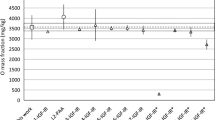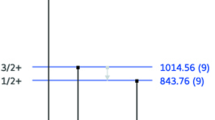Abstract
A particle induced γ-ray emission methodology employing the 18O(p,p′γ)18O (E γ = 1982 keV) nuclear reaction is described for the non-destructive determination of bulk oxygen in materials. The development of the methodology follows a comprehensive measurement of the thick target yields of the 1982 keV prompt γ-rays in the 3.0–4.2 MeV proton energy region and a systematic assessment of such analytical features as the limit of detection, probing depth, precision and accuracy. The methodology is validated by analyzing binary, ternary and multinary oxides. It is simple and rapid, and in combination with prompt γ-ray producing reactions involving the other constituents, enables the complete compositional analysis of oxygen bearing materials.







Similar content being viewed by others
References
Zheng J, Xiao J, Zhang Ji-Guang (2016) The roles of oxygen non-stoichiometry on the electrochemical properties of oxide-based cathode materials. Nano Today 11:678–694
Ganduglia-Pirovano MV, Hofmann A, Sauer J (2007) Oxygen vacancies in transition metal and rare earth oxides: current state of understanding and remaining challenges. Surf Sci Rep 62:219–270
Cohen DD, Rose EK (1992) Analysis of oxygen by charged particle bombardment. Nucl Instr Meth B 66:158–190
Amsel G, Samuel D (1967) Microanalysis of the stable isotopes of oxygen by means of nuclear reactions. Anal Chem 39(14):1689–1698
Csedreki L, Huszank R (2015) Application of PIGE, BS and NRA techniques to oxygen profiling in steel joints using deuteron beam. Nucl Instr Meth B 348:165–169
Luomajarvi M, Rauhala E, Hautala M (1992) Oxygen detection by non-Rutherford backscattering below 2.5 MeV. Nucl Instr Meth B 9:255–258
Leavitt JA, McIntyre LC Jr, Ashbaugh MD, Oder JG, Lin Z, Dezfouly-Arjomandy B (1990) Cross sections for 170.5° backscattering of 4He from oxygen for 4He energies between 1.8 and 5.0 MeV. Nucl Instr Meth B 44:260–265
Vickridge IC, Tallon J, Presland M (1994) High precision determination of 160 in high Tc superconductors by DIGME. Nucl Instr Meth B 85:95–99
Vickridge IC, Tallon J, Presland M (1995) 16O DIGME of high Tc materials. Nucl Instr Meth B 99:450–453
Raisanen J (1986) A rapid method for carbon and oxygen determination with external proton induced gamma-ray emission analysis. Nucl Instr Meth B 17:344–348
Chhillar S, Acharya R, Tripathi R, Sodaye S, Sudarshan K, Rout PC, Mukerjee SK, Pujari PK (2015) Compositional characterization of lithium titanate ceramic samples by determining Li, Ti and O concentrations simultaneously using PIGE at 8 MeV proton beam. J Radioanal Nucl Chem 305(2):463–467
Kumar S, Sunitha Y, Reddy GLN, Sukumar AA, Ramana JV, Sarkar A, Verma R (2016) Oxygen determination in materials by 18O(p,αγ)15 N nuclear reaction. Nucl Instr Meth B 378:38–44
Kiss AZ, Koltay E, Nyako B, Somorjai E, Anttila A, Raisanen J (1985) Measurements of relative thick target yields for PIGE analysis on light elements in the proton energy interval 2.4–4.2 MeV. J Radioanal Nucl Chem 89:123–141
Mateus R, Jesus AP, Ribeiro JP (2005) A code for quantitative analysis of light elements in thick samples by PIGE. Nucl Instr Meth B 229:302–308
Ziegler JF, Biersack JP, Ziegler D (2013) SRIM- The Stopping and Range of Ions in Matter. http://www.srim.org/
Mayer M (1997) SIMNRA user’s guide, Report IPP 9/113. Max Planck Institute for Plasmaphysik, Garching, Germany
Bashkin S, Richards HT (1951) Proton bombardment of the lithium isotopes. Phys Rev 84:1124–1129
Malmberg PR (1956) Elastic scattering of protons from Li7. Phys Rev 101:114–117
Gurbich AF (1998) Evaluation of non-Rutherford proton elastic scattering for cross section carbon. Nucl Instr Meth B 136–138:60–65
Gurbich AF (1997) Evaluation of non-Rutherford proton elastic scattering for cross section oxygen. Nucl Instr Meth B 129:311–316
Ajzenberg-Selove F (1986) Energy levels of light nuclei A = 16–17. Nucl Phys A 460(1):1–110
Ajzenberg-Selove F (1987) Energy levels of light nuclei A = 18–20. Nucl Phys A 475(1):1–198
Sunitha Y, Kumar Sanjiv (2017) Depth profiling Li in electrode materials of lithium ion battery by 7Li(p, γ)8Be and 7Li(p, α)4He nuclear reactions. Nucl Instr Meth B 400:22–30
Rauhala E, Keinonen J (1988) Ion beam analysis of oxygen distribution in superconducting YBa2Cu3Ox. Appl Phys Lett 52:1520–1522
Habrioux A, Surblé S, Berger P, Khodja H, D’Affroux A, Mailley S, Gutel T, Patoux S (2012) Nuclear microanalysis of lithium dispersion in LiFePO4 based cathode materials. Nucl Instr Meth B 290:13–18
Colaux JL, Jeynes C, Heasman KC, Gwilliam RM (2015) Certified ion implantation fluence by high accuracy RBS. Analyst 140:3251–3261
Fehrenbacher G, Meckbach R, Paretzke HG (1996) Fast neutron detection with germanium detectors: computation of response functions for the 692 keV inelastic scattering peak. Nucl Instr Meth A 372:239–245
Sunitha Y, Kumar Sanjiv (2017) 10B/11B isotopic ratio and atomic composition of boron carbide: determination by proton induced γ-ray emission and proton elastic backscattering spectrometry. Appl Radiat Isot 128:28–35
Mateus R, Jesus AP, Braizinha B, Cruz J, Pinto JV, Ribeiro JP (2002) Proton-induced γ-ray analysis of lithium in thick samples. Nucl Instr Meth B 190:117–121
Acknowledgements
The authors gratefully acknowledge the useful comments and suggestions of Dr. P. D. Naik, Associate Director, Chemistry Group, BARC and Dr. Sunil Jai Kumar, Head, NCCCM, Hyderabad. The authors thank Prof. C. Sudakar for providing LiFePO4 and LiFePO4/C samples.
Author information
Authors and Affiliations
Corresponding author
Rights and permissions
About this article
Cite this article
Sunitha, Y., Kumar, S. 18O(p,p′γ)18O nuclear reaction in the determination of oxygen by proton induced γ-ray emission. J Radioanal Nucl Chem 314, 1803–1812 (2017). https://doi.org/10.1007/s10967-017-5575-5
Received:
Published:
Issue Date:
DOI: https://doi.org/10.1007/s10967-017-5575-5




